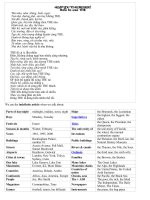Ways to describe the place
Bạn đang xem bản rút gọn của tài liệu. Xem và tải ngay bản đầy đủ của tài liệu tại đây (2.01 MB, 10 trang )
Describing
Describing
places
places
Authors: Pham Thi
Thanh
Pham Thi
Nguyet
Vien Van Thi
A descriptive paragraph describes a place
so that the reader can imagine it in his or her
mind.
A descriptive paragraph which describes a
place has a topic sentence, supporting
sentences, and a concluding sentence.
• Topic sentence: The topic sentence
introduces the place that the writer will
describe.
• Supporting sentences: The supporting
sentences give some background
information about the place. They also
give descriptive details about the place.
These details describe how the place look.
They may also describe in more detail
how the writer feels about the place.
• Concluding sentence: A concluding
sentence restates the idea in the topic
sentence using different words. It may also
include the writer’s general feeling or a
opinion about the place.
•
In a paragraph describing places, writer also
often use spatial order to organize their ideas.
Spatial order is the arrangement of items in
order by space. For example, when describing
your favorite room at home, you could first
describe things on the left side of the doorway
and then move clockwise around to the right
side. You could also start on the right and move
counterclockwise around to the left. If you
jumped back and forth, it would be very difficult
for the reader to try to see the room in his or her
mind. It is helpful to use some kind of spatial
order when you write a description.
Spatial order words and phrases
Just as there are words and phrases to
show time order, there are words and
phrases to show spatial organization. They
are often prepositional phrases of location
or position. Some spatial order expressions
are:
+ at the top of + between
+ in the center + behind
+ on the left + in back of
+ in front of + inside
+ next to + across from
The stairway
By Toshiki Yamazaki
“When I was 2 or 3 years old, I lived in a house that
had a strange atmosphere. I do not remember anything
about the house except the stairway. It was the dark,
squeaking, and quite narrow, and its steps were a little
high for me to climb up. From the bottom of the
stairway, it seemed like an endless climb to the top.
Beyond the darkness at the top of stairway, there was
the middle-aged, elegant lady leaning against the wall. I
had to pass her every time I went to my room, for my
room was the first room from the stairs on the second
floor. The lady wore a beautiful dress with a quiet
pattern and a tinge of blue, and her peaceful eyes,
stared at me ever time I went up the stairs.
Example:
As I carefully climbed up the last step, her eyes
became fixed on me. I was scared, yet I was also
curious about the lady. She didn’t talk, nor did she
move. She just stood there and watched me climbed
up the stairs. One day I touched her, but she did not
react. Her face did not change expression, nor did
she even blink. She just kept staring at me with her
glittering eyes. Later, we moved out of the house,
and I never saw her again. Now I know that the lady
was a mannequin. My aunt, whom I lived with, used
it for her dressmaking class. I did not know my
mother. May be I imagined that the mannequin
standing at the top of the stairs was my mother. The
stairway with the strange atmosphere has an
important place in my earliest memories.”
• The model paragraph “the stairway” uses spatial
organization. In describing the stairway, the writer shows
that as a little boy, his first view was from the bottom
looking up at the mannequin. Then he climbed up the
stairway until he reached the top. Thus, spatial
organization is from bottom to top.
•
In the first sentence, the writer say that the atmosphere
of the house is strange. The writer describe that the
stairway is the dark, squeaking and quite narrow, and its
step are a little high for her to climb up. Then he
describes the woman: “Beyond the darkness … … … I
went up the stairs.”
The end
Thanks for listening !









